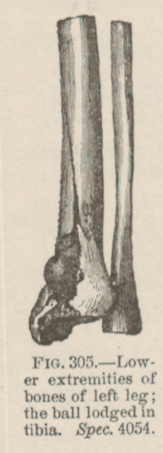Title: Vermilyea, L.
Source text: The Medical and Surgical History of the War of the Rebellion. (1861-65.), Part 3, Volume 2 (Washington, DC: Government Printing Office, 1883), 528.
Civil War Washington ID: med.d2e20329
TEI/XML: med.d2e20329.xml
CASE 772.—Private L. Vermilyea, Co. K, 91st New York, aged 21 years, was wounded at Gravelly Run, March 31, 1865. He was conveyed to the field hospital of the 3d division, Fifth Corps, whence Surgeon A. S. Coe, 147th New York, reported "a bullet wound with fracture of left ankle joint." Surgeon A. F.Sheldon, U. S. V., reported the following description and result of the injury: "A musket ball entered the lower extremity of the tibia anteriorly, fracturing it into the joint and upwards for four inches. The wounded man was admitted to Campbell Hospital at Washington, six days after the injury. Suppuration set in about the wounded foot and extended to the muscle of the calf and the patient suffered considerable fever and irritation of the system. On April 11th, circular amputation of the lower third of the leg was performed by Assistant Surgeon A. Delany, U. S. V., the operation being attended with the usual amount of hæmorrhage and three ligatures being applied. Anæsthesia was produced by sulphuric ether. The patient did well after the operation, and was discharged from service June 19, 1865." Several months later he was furnished with an artificial limb by the Salem Leg Company. The amputated portions of the bones of the leg (Spec. 4054) were contributed to the Museum by the operator and are represented in the annexed wood-cut (FIG. 305), showing the tibia to be fractured by a round ball, which is lodged just above the ankle, fissuring into it. In his first application for commutation, dated 1870, the pensioner represented the stump as being in a sound condition, but in subsequent statements he reported it as troublesome. The Albany Examining Board, on February 5th, 1879. certified to the amputation, and stated that "the stump is tender and abscesses occasionally form on the posterior aspect of the leg, more especially if an artificial limb is worn for a few weeks at a time. The pensioner also states that he has neuralgic pains and is now and then laid up for from one to three weeks." The pensioner was paid June 4, 1880.
